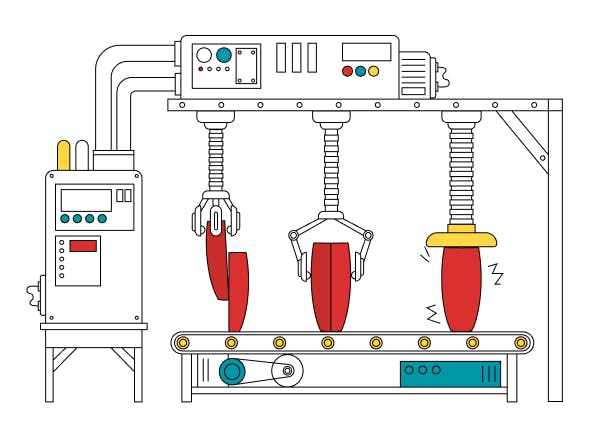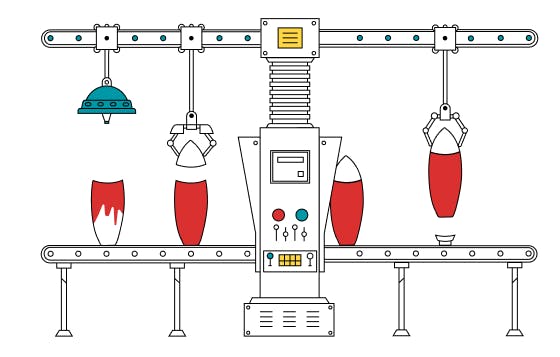Automation Trends in Business

The automation landscape is evolving rapidly, driven by groundbreaking technologies reshaping business operations.
Here's a look at some key trends:
Increased Use of AI and ML
Artificial intelligence (AI) and machine learning (ML) drive intelligent automation, enabling systems to learn, adapt, and make decisions. This trend will accelerate in the years to come.
- Adaptability: Unlike rule-based automation, AI-powered systems evolve and improve over time, responding to new data and changing environments.
- Complex task automation: AI and ML can tackle tasks that were once considered the exclusive domain of humans, such as natural language understanding, image recognition, and even creative content generation.
Example: AI-Powered Chatbots
AI-powered chatbots are a great example. Older chatbots followed rigid rules and often failed to understand complex queries.
Now, with natural language processing (NLP), chatbots understand the intent behind questions, even if phrased differently.
They learn from each interaction, improving their ability to recognise patterns and provide accurate responses. They can even adapt to new product launches or slang, understanding and answering questions without needing explicit reprogramming.
AI chatbots handle complex tasks like sentiment analysis (understanding customer emotions), personalised recommendations, and multi-lingual support.
Process Intelligence:
X-Ray Vision for Your Business
Process intelligence (PI) gives you unprecedented visibility into how your business processes work. By analysing data from various sources, PI tools reveal bottlenecks, inefficiencies, and opportunities for optimisation. This translates into tangible benefits for your organisation, including:
- Data-driven insights: PI leverages process mining and task mining to create visual maps of your processes, highlighting where they deviate from the ideal path.
- Continuous improvement: Armed with these insights, you can pinpoint areas for improvement, streamline workflows, and eliminate waste.
Example: Streamlining an Order Fulfilment Process
Imagine a large online retailer handling numerous customer orders daily. Their order fulfilment process will involve multiple steps.
Without process intelligence, they only see the overall time to fulfil an order. But with PI tools, they get a deeper look.
They can see each step's length, identify bottlenecks where orders get delayed, and uncover inefficiencies. By visualising the entire process like an X-ray, the retailer can pinpoint problems they didn't know existed.
With this data, they can make targeted improvements. They could optimise warehouse layouts, automate tasks, or adjust staff schedules to address bottlenecks.
By continuously monitoring the process with PI, they can ensure that their order fulfilment remains efficient and customer-centric.

Intelligent Document Processing (IDP): Unleashing the Power of Unstructured Data
Intelligent Document Processing (IDP) uses AI to extract valuable information from unstructured documents like invoices, contracts, and emails.
It goes beyond simple OCR by understanding the context and meaning of the data.
- Automated data extraction: IDP eliminates the need for manual data entry, reducing errors and accelerating processes.
- Enhanced decision-making: By extracting and organising data from documents, IDP provides valuable insights for decision-makers.
- 💡Key point: What is Optical Character Recognition (OCR)?
OCR is a technology that converts images of text, whether typed, handwritten, or printed, into machine-readable text format.
This means that instead of just having a picture of a document, OCR allows you to have the actual text content in a format that can be edited, searched, and manipulated by a computer.
Example: Streamlining Data Entry in Healthcare
Imagine a large healthcare provider receiving hundreds of patient intake forms daily. Traditionally, staff manually entered this data — a time-consuming and error-prone process.
The provider can automate this with intelligent document processing (IDP). An IDP solution scans and "reads" these forms, extracting necessary data like medical history and allergies.
IDP goes beyond text recognition; it understands context, differentiating "acetaminophen" under "allergies" from "current medications."
By automating data extraction, the provider reduces manual effort and minimises errors. The IDP system also categorises the data, making it easily accessible for healthcare professionals.
Cobots: The Rise of Collaborative Robots
Collaborative robots, or cobots, are designed to work safely alongside humans, enhancing their capabilities and improving safety.
- Augmenting human skills: Cobots handle repetitive, dangerous, or physically demanding tasks, freeing up humans for more creative and strategic work.
- Flexibility and adaptability: Cobots are easily reprogrammed and redeployed, making them ideal for dynamic work environments.
Example: Cobots in Manufacturing
Traditionally, in car manufacturing plants, heavy lifting, and repetitive tasks were done by robots in caged-off areas, separate from human workers.
With cobots, this changes. Cobots are designed with safety features like force sensors, allowing them to work alongside humans on the assembly line.
They can assist with tasks that require precision or strength, like holding a car door while a human worker secures it. If the cobot senses resistance, it stops to avoid injury.
This collaboration is easily adaptable. If the assembly line needs reconfiguring, the cobot can be quickly reprogrammed. Cobots can also be used for quality control.
They are equipped with cameras and sensors to inspect parts and identify defects, freeing human workers for more complex tasks.
Hyperautomation
Hyperautomation combines multiple automation technologies, such as RPA, AI, ML, and IDP, to optimise entire business processes end-to-end.
- End-to-end efficiency: By automating complex workflows across multiple systems, hyperautomation eliminates manual handoffs and reduces errors.
- Continuous improvement: Hyperautomation solutions leverage data and analytics to continuously monitor and optimise processes.
Example: Order Fulfilment
Hyperautomation can also transform order fulfilment processes. Let's say a major online retailer receives an order.
Intelligent Document Processing (IDP) software extracts relevant details like shipping addresses and items ordered as soon as the order is placed.
This data seamlessly flows into a Robotic Process Automation (RPA) system that verifies inventory levels and initiates the fulfilment process.
The RPA bot then updates the order status, triggers packing instructions at the warehouse, and notifies the shipping carrier.
Next, machine learning models constantly monitor the entire process, identifying potential delays and optimising routes to ensure timely delivery.

Other Automation Trends
Here are a few additional trends shaping the automation landscape:
Low-Code/No-Code Automation Platforms
These platforms empower non-technical users to create and deploy automation without writing complex code. This democratises automation, making it accessible to a broader range of businesses and individuals.
A great example of this would be a marketing team using a no-code platform to automate their social media posting schedule.
Emphasis on Cybersecurity and Ethical Automation
As automation becomes more prevalent, so does the need for robust security measures to protect against cyberattacks and ensure data privacy. Additionally, ethical considerations around job displacement and potential biases in AI algorithms are gaining more attention.
The Rise of Autonomous Systems
Autonomous vehicles, drones, and robots are becoming increasingly sophisticated, powered by advances in AI, sensors, and navigation technologies.
For example, a logistics company could deploy autonomous drones for package delivery, reducing costs and improving delivery times.
Digital Twin Technology
Digital twins are virtual replicas of physical assets or processes that can be used for simulation, testing, and optimisation.
For example, a manufacturing plant creates a digital twin of its production line to simulate different scenarios and optimise efficiency before making changes in the real world.
Human-Machine Collaboration
The future of automation is not about replacing humans but rather empowering them. We're shifting towards collaborative models where humans and machines work together, leveraging their strengths to achieve greater outcomes.
For instance, a surgeon could use a robotic arm to assist in a delicate surgery, combining their expertise with the robot's precision.
Emphasis on Sustainability and Green Automation
As environmental concerns grow, interest is rising in developing energy-efficient and environmentally friendly automation solutions.
This includes using renewable energy sources, optimising resource consumption, and developing sustainable automation technologies.



